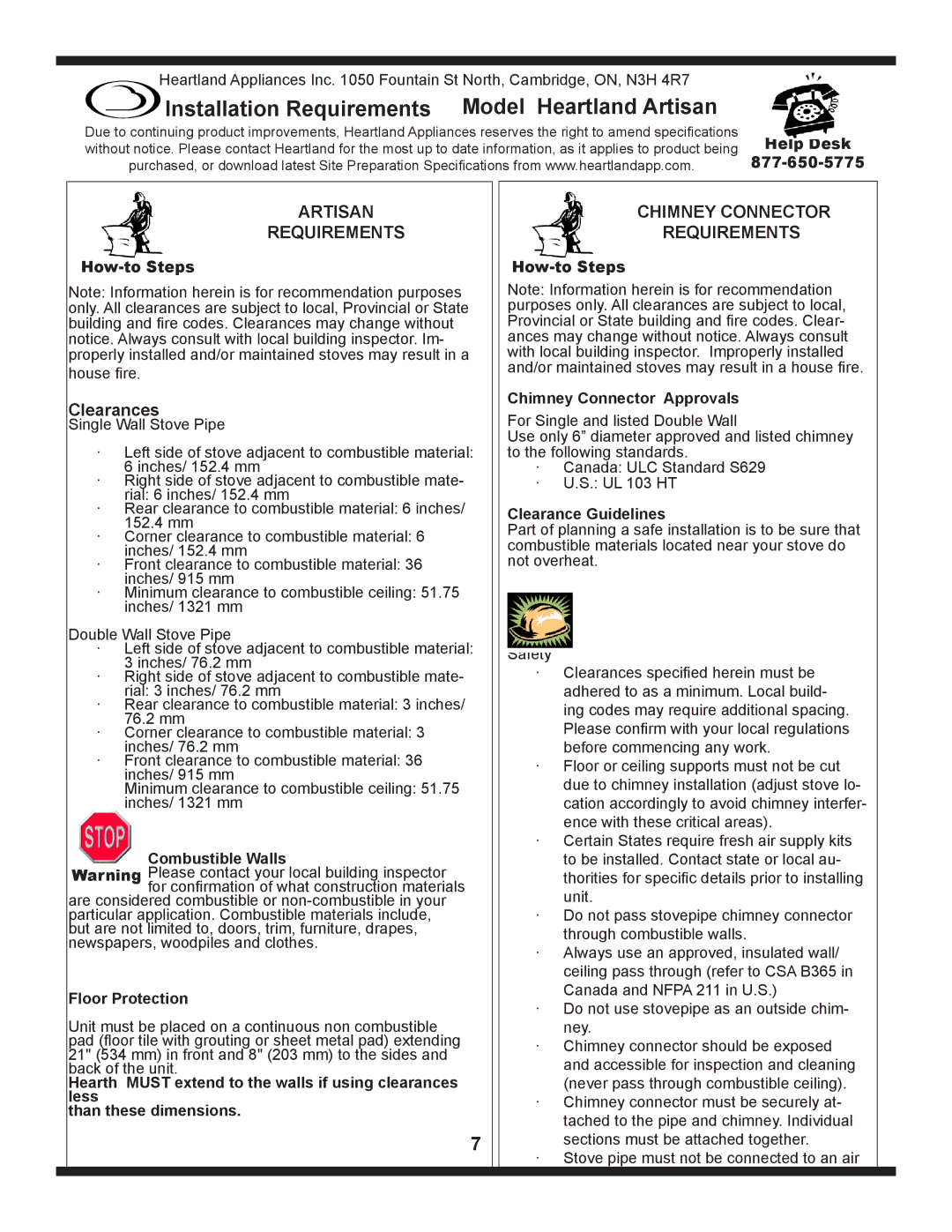
Heartland Appliances Inc. 1050 Fountain St North, Cambridge, ON, N3H 4R7
Installation Requirements Model Heartland Artisan
Due to continuing product improvements, Heartland Appliances reserves the right to amend specifications | Help Desk |
without notice. Please contact Heartland for the most up to date information, as it applies to product being | |
purchased, or download latest Site Preparation Specifications from www.heartlandapp.com. |
ARTISAN
REQUIREMENTS
Note: Information herein is for recommendation purposes only. All clearances are subject to local, Provincial or State building and fire codes. Clearances may change without notice. Always consult with local building inspector. Im- properly installed and/or maintained stoves may result in a house fire.
Clearances
Single Wall Stove Pipe
·Left side of stove adjacent to combustible material: 6 inches/ 152.4 mm
·Right side of stove adjacent to combustible mate- rial: 6 inches/ 152.4 mm
·Rear clearance to combustible material: 6 inches/ 152.4 mm
·Corner clearance to combustible material: 6 inches/ 152.4 mm
·Front clearance to combustible material: 36 inches/ 915 mm
·Minimum clearance to combustible ceiling: 51.75 inches/ 1321 mm
Double Wall Stove Pipe
· Left side of stove adjacent to combustible material: 3 inches/ 76.2 mm
· Right side of stove adjacent to combustible mate- rial: 3 inches/ 76.2 mm
· Rear clearance to combustible material: 3 inches/ 76.2 mm
· Corner clearance to combustible material: 3 inches/ 76.2 mm
· Front clearance to combustible material: 36 inches/ 915 mm
Minimum clearance to combustible ceiling: 51.75 inches/ 1321 mm
Combustible Walls
Warning Please contact your local building inspector for confirmation of what construction materials
are considered combustible or
Floor Protection
Unit must be placed on a continuous non combustible pad (floor tile with grouting or sheet metal pad) extending 21" (534 mm) in front and 8" (203 mm) to the sides and back of the unit.
Hearth MUST extend to the walls if using clearances less
than these dimensions.
CHIMNEY CONNECTOR
REQUIREMENTS
How-to Steps
Note: Information herein is for recommendation purposes only. All clearances are subject to local, Provincial or State building and fire codes. Clear- ances may change without notice. Always consult with local building inspector. Improperly installed and/or maintained stoves may result in a house fire.
Chimney Connector Approvals
For Single and listed Double Wall
Use only 6” diameter approved and listed chimney to the following standards.
· Canada: ULC Standard S629
· U.S.: UL 103 HT
Clearance Guidelines
Part of planning a safe installation is to be sure that combustible materials located near your stove do not overheat.
Safety
·Clearances specified herein must be adhered to as a minimum. Local build- ing codes may require additional spacing.
Please confirm with your local regulations before commencing any work.
·Floor or ceiling supports must not be cut due to chimney installation (adjust stove lo- cation accordingly to avoid chimney interfer- ence with these critical areas).
·Certain States require fresh air supply kits to be installed. Contact state or local au- thorities for specific details prior to installing unit.
·Do not pass stovepipe chimney connector through combustible walls.
·Always use an approved, insulated wall/ ceiling pass through (refer to CSA B365 in Canada and NFPA 211 in U.S.)
·Do not use stovepipe as an outside chim- ney.
·Chimney connector should be exposed and accessible for inspection and cleaning (never pass through combustible ceiling).
·Chimney connector must be securely at- tached to the pipe and chimney. Individual sections must be attached together.
·Stove pipe must not be connected to an air
